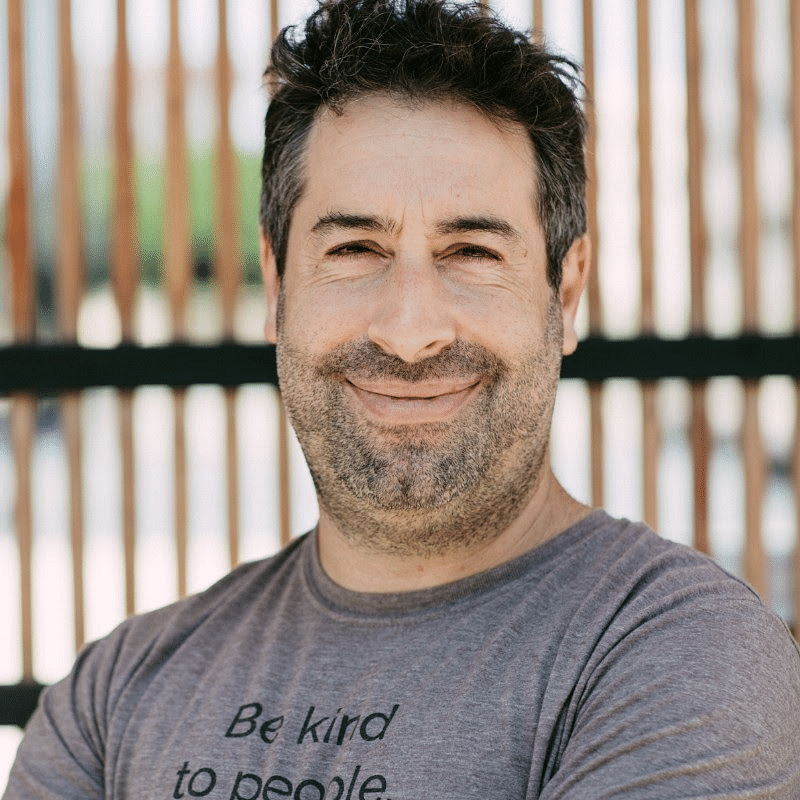
Entrepreneur and storyteller Nir Zavaro on repurposing content more efficiently, rethinking how slides should be done
By Jim James, Founder EASTWEST PR and Host of The UnNoticed Entrepreneur.
In the newest The UnNoticed Entrepreneur podcast episode, I went all the way to Israel, taking you with me to meet Nir Zavaro and talk about how he helps entrepreneurs get noticed.
Image from LinkedIn
Efficient Content Creation
Every person on the planet wants to talk and be listened to. If someone asks you, “Hi, how are you? What do you do?” You can ramble on and on for days and you won’t shut up about it. Now, if you’ll be asked to turn that into amazing content, Nir said that there could be two possibilities: You could say “I’d love to, but I don’t know what to do” or “I don’t know what to say.”
It shows how all of a sudden, people clam up and get stuck.
What Nir and his team do is to help you understand that you can ramble on and on. You just need to find the right ways to record it and create content.
For instance, he’d jump on a call with me and ask me a simple question, “Could you give me three tips about podcasting?” Having done about 430 episodes, he assumed that if he’d ask me to tell him in 60 seconds what I do with my podcast and what are the three tips that I could teach him if he wants to start his podcast, I could probably give at least a dozen good tips.
But for Nir, three tips are enough. If I summarise that and record it, I will have about four or five minutes of video content. This is what they call a pillar piece of content, which they will then start dividing so that every tip that I mentioned would be a video. They’ll take on one quote and create video content out of that.
In sum, Nir and company can create about 30 pieces of content on every social platform using a five-minute video.
It’s About Value
When asked about which question can prompt a conversation, Nir said that it’s about what you can teach.
No one wants to hear about your problems. People don’t care. But if you give them some value, it becomes something because everyone talks about value.

Image from Unsplash
For example, you wrote a book. People might say that they’ve read these 30,000 or 40,000 words and they remember one tip. They could have spent eight hours listening to an audiobook or reading, but in the end, they only get one or two takeaways of your book.
At the end of the day, it really comes down to the essence of what you’ve learned.
If you do tips, it’s easy because you can create many on a weekly basis. If he asked me about tips for the podcast and I’d give him a dozen, we already have four videos.
You can go on platforms like Descript wherein you can put in the notes. The moment you do that, you already have subtitles. Then you can divide that, take one picture, add that to the video, and have a thumbnail. Then you can publish that on Twitter, for example.
It’s a transformative tool for content creation and repurposing.
You can take a five-minute video (which has about a thousand words) and do a transcript, which becomes your blog post. You can take those blog posts, copy their URL to Medium, and now, you have to articles.
You also have the main video that can go on YouTube. Every tip will also have a separate video, so that’s three more videos on YouTube. You can also upload them on Facebook, Instagram, LinkedIn, Twitter, or wherever you want. So that’s another 16 videos.
The important thing is that you don’t upload them all at once. What you need to do is to create a content calendar. For example, if you have four five-minute videos, you can have the main one go in the first week. Then, the second video will go in the third or fourth week, and so on. This will give you about a hundred pieces of content for the next quarter.
Nir shared that he was recently in London to write his new book called “Fuck the Slides.” For 30 days, he didn’t have the time to upload almost anything in terms of video. But his team was still able to keep uploading short videos on social media through the said strategy.
Managing Schedules of Content
Scheduling is another part of the program. Once you’ve done production and post-production, you’ll have to manage promotion and schedules.
Image from Unsplash
Nir shared that internally, they use everything — from Monday to Trello — as there are many different platforms available today. But when it comes to social platforms, he said that it depends on the clients. His agency Streetwise offers outsourced marketing services. So they take a big content calendar and break it down because they work with companies with different platforms.
For him, the simplest way that you won’t get confused is by opening a spreadsheet. You record your five-minute video, and say that that is your main pillar. Then create three more videos for each of the tips that you can put out on Facebook, Twitter, or LinkedIn. Then add all those details on the spreadsheet.
Remember, however, that you can’t handle or do all platforms.
For example, he himself has been enjoying more of Twitter and a little bit of LinkedIn for the last couple of months. It means that the usual content that they upload will go to all platforms but they dedicate less time now, for example, in uploading on or communicating via Facebook. While he’s still on the platform (he posts about two to three times a week), he doesn’t spend all his attention on Facebook.
The idea of focusing on one platform is helpful. While you can schedule the posts, it’s the follow-up to get the engagement that really takes the time.
Engaging in Social Media
Talking about Twitter and LinkedIn, Nir mentioned that all he’s interested in are the hashtags that might be relevant for his business or hashtags that he knows he could be of help to someone.

Image from Unsplash
What he does is to go on tweets and follow the thread, then look at the replies. For example, there’s a good thread about social marketing. He might see a guy who posted five or six tweets and the filter of the photo is really good, he’ll give his two cents, then everybody will see them.
He’ll also go to the hundreds of comments, start liking and replying to things so that he can give value. This goes back to him wanting to be heard.
It’s also about wanting to serve others because you can answer other people’s problems as opposed to necessarily just posting your own views.
Nir also talked about being a member of the EO or Entrepreneurs' Organisation when servant leadership was mentioned during the episode.
As a member, he doesn’t just pay money to be a member. He also volunteers his time to help other entrepreneurs in the organisation. Though some of them are even more successful than he is in terms of money or size, he still volunteers his time to help improve the organisation so their members can get better, succeed, grow, and hire more people.
The EO Media House
Nir has been in charge of marketing for the last couple of years within EO. And during the last six months, he mainly focused on building a media house for entrepreneurs in Europe. This means that they become the creators of the content.
They have a website for EO Europe that they’re now populating with good stories by entrepreneurs. It’s not about EO itself but interesting success stories — stories about love, failure, money, and anything that you can think about such as scaling. EO currently has 23 chapters and around 1,800 members are giving them stories.
He’s also doing a podcast where he interviews EO members. Again, this is about trying to give value to young entrepreneurs throughout the continent of Europe.
Now, they’re also creating an interesting concept wherein they reach out to people from the same industry in different countries. Then, Nir is going to facilitate an event starting in January.
If you have a public relations agency, this will give you the chance to talk to people from different nations about the same topics and, in the process, get value and understand that EO is the place to be. Or if you want to open a PR agency or you’re at the beginning phases, you can attend and find value in listening.
If the media house becomes strong enough, the next phase would be to launch an entrepreneur’s newsletter. The newsletter will curate content from all the things that they do. Then, the next step is to create more content in terms of videos and articles from their partners. Recently, EO signed with Fiverr as a partner. Nir shared that they want them to start giving them content.
All these show that there’s a lot of variations as to how you can start creating content.
Reframing How Slides Should Be
Nir’s new book seems to not be a fan of slides.
Image from Unsplash
However, he clarified that he and his team still use slides. The problem is this: He’s been doing mentorship in accelerators, hubs, and startup companies for years. But when he goes to a demo day and there'll be 10 companies, for instance, he can’t distinguish them and he can’t understand what they do. He doesn’t even get what’s so interesting about them or what are the differences among them. They all look the same. The structure that people are used to doing is opening PowerPoint and populating it.
When he asks a startup or a manager whether their presentation is ready, they’d respond yes. But though their slides are ready, their presentation is not.
This means that there’s a need to rethink the way we create the process. It’s still about the slides because that’s the way the world works. You can’t talk to an investor and not have slides. There’s a common way of doing things but you can start with a story, with what are you going to say.
Nir then related it to watching a movie. When you go to see movies, there’ll be a trailer for a new film which can compel you to watch it when it will be released when it comes out.
For years, people have called it the elevator pitch. It doesn’t have many slides. During demo day, Nir recommended having this, which he renamed as the trailer pitch.
In three minutes, you need a trailer pitch enough for an investor to want to get more. You’re not actually selling them everything. You’re selling an idea.
According to him, the three-minute pitch has a structure and a hook. Once you understand what’s in it, you build the slides. For example, you can start with a good case study for about 30 seconds. Then the next slide could be about the competition. It’s not necessarily a problem-solution format.
If you look at entrepreneurs’ or companies’ presentations and run through the slides, you may feel that they’re not connected or they’re not interesting. But if you tell an amazing story about something that happened to someone — and how it also happens to a hundred million people more and how you can solve it for them — you might actually make a bit of money. You can ask your investors to give you a hundred thousand dollars and help you change the world.
On the ‘Fuck the Slides’ Book
Nir’s new book is mainly focused on the structure of how slides should be; how to create everything — from thinking about the hook to making sure that you have all you need. There’s also a chapter about the things that you’ll need at a later stage in terms of content creation.
Image from Unsplash
When people tell you before a meeting about sending them the deck, it has been mistaken over the years that it’s about sending the same presentation. Nir said that it can’t be the same presentation.
Why? Because when you have the trailer pitch, you are the presentation. This means that your audience shouldn’t read. If they read, they won’t be able to listen because this is how humans are structured biologically.
But if you’ll be asked to send the slides before your meeting and you send the same presentation, you won’t be able to be there — you won’t be present. That kind of presentation is what he renamed as the toilet deck because people will read it in their own free time; most of them do it while in the toilet.
If you have a trailer pitch, however, the next step is to understand the structure in terms of design. How are you going to speak? In this aspect, sometimes, a good pause is a good thing because it also says something.
Nir’s book also has the do’s and don’ts of a presentation. Some of them talk about intonation, why he loves standup comedians, and why, sometimes, you need to understand that for the sake of that presentation, you can say and do whatever you want.
“Fuck the Slides” is his third book and it’s planned to be published in the first week of April.
Getting Noticed while Locked Down
On his website, www.nirzavaro.com, there’s a part in his vision where he wrote that he wants to meet all the people on the planet or as many people as he can and he wants to do as much good. He also understands that most probably, he won’t meet all the people on the planet and he won’t always do good.
Image from Nir Zavaro’s website
So part of that is to understand that he does want to actively meet people, learn from them, and grow. Just the idea of being in a company.
In March 2020, Israel was already locked down before the whole world did so. Nir lost about 80% of his business in less than 10 days. When his business was down and he didn’t know what he could do, the best solution that he came up with was to start calling people on his phone.
Every day, he’d call 10 people and ask about how they’re holding up and how he can help them. He lost 80% of his business and he had some free time, and if they need something, he can help. One person said yes. And that’s how he got a client.
Then, he also reached out to someone who does something similar but in a different industry. That became his second client. He kind of started rebuilding through that: Every day, when he leaves the office, he goes on his motorbike, he has a speaker, and he’ll call someone that he hasn’t spoken to in a long time.
At the end of the day, it’s about continuing to provide service.
To find out more about Nir, check out his website. He’s also on Twitter and LinkedIn. You can also email him at zavaro@streetwise.co.il.
This article is based on a transcript from my podcast The UnNoticed Entrepreneur, you can listen here.
Cover image by Startup Stock Photos on Pexels






